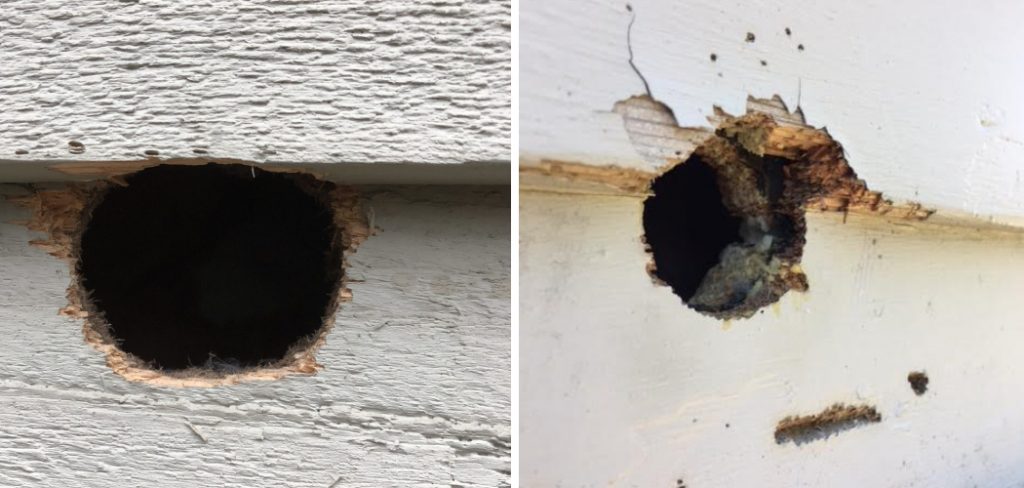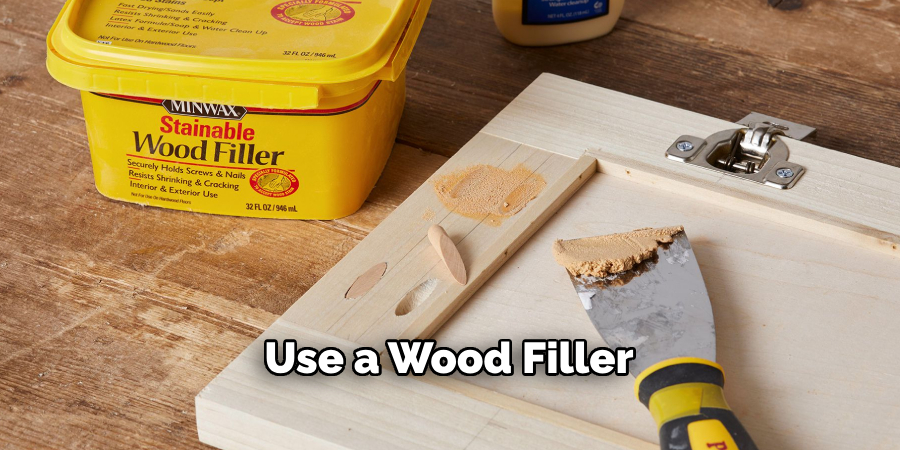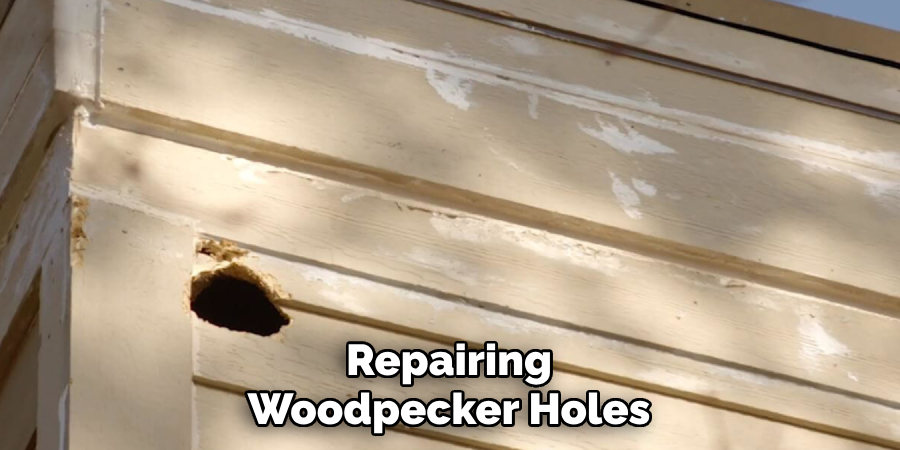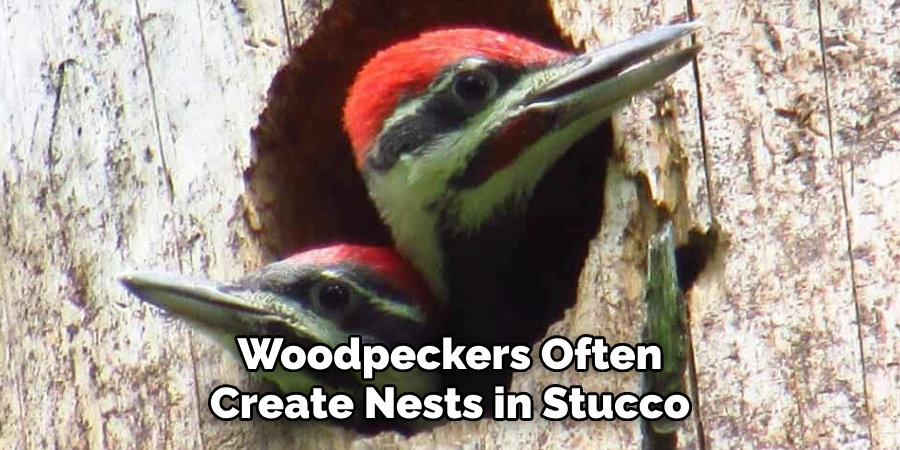Woodpeckers are known for creating holes in trees, but did you know they can also create holes in stucco? These holes not only cause cosmetic damage to your home’s exterior, but they can also leave it vulnerable to water and pest infiltration. As a homeowner, it is important to know to fix woodpecker holes in stucco so you can maintain the integrity of your home and prevent further damage.

The main advantage of knowing to fix woodpecker holes in stucco is that you can save time and money by repairing the damage yourself. Hiring a professional to do the job can be costly, especially if it’s just a small hole or two. Additionally, being able to fix the holes yourself allows you to have control over the repair process and ensure that it is done correctly. In this blog post, You will learn in detail how to fix woodpecker holes in stucco.
Step-by-step Instructions for How to Fix Woodpecker Holes in Stucco
Step 1: Inspect the Damage
To begin with, you’ll need to conduct a thorough inspection of the woodpecker damage on your stucco. Look for holes, cracks or other signs of damage. Once you have identified the extent of the damage, gather all necessary materials and tools. This may include a ladder, patching compound, putty knife, and sandpaper.
Step 2: Clean the Area
Using a clean cloth or brush, remove any debris or loose stucco around the damaged area. This will ensure that the patching compound adheres properly to the surface. Follow the instructions on your chosen patching compound to mix it correctly. Make sure it has a smooth and workable consistency.
Step 3: Apply Patching Compound
Using a putty knife, apply the patching compound to the damaged area. Make sure to fill in any cracks or holes completely and smooth out the surface. Allow the patching compound to dry completely according to the instructions on the product label. This can take anywhere from a few hours to a full day.
Step 4: Sand the Area
Once the patching compound has dried, use sandpaper to smooth out the surface. This will help blend the repair with the surrounding stucco. If your stucco is painted, you may need to paint over the patched area to match the rest of the surface. Use a color that closely matches your existing stucco.

Step 5: Install Deterrents
To prevent future woodpecker damage, consider installing deterrents such as reflective tape or visual decoys near the affected area. Keep an eye on the repaired area and monitor for any further woodpecker damage. If you notice new holes or cracks, repeat the repair process.
Step 6: Seek Professional Help
If the damage is extensive or if you are not comfortable with DIY repairs, it’s best to seek professional help. They will have the expertise and tools to properly fix the stucco. To prevent woodpecker damage in the future, make sure to regularly inspect and maintain your stucco. Fill in any cracks or holes as soon as you notice them to avoid further damage.
By following these step-by-step instructions, you can effectively fix woodpecker holes in stucco and prevent future damage. Remember to always prioritize safety and consider seeking professional help if needed. With proper maintenance, your stucco will remain in good condition for years to come.
Safety Tips for How to Fix Woodpecker Holes in Stucco
- Always wear protective gear such as goggles, gloves and a face mask when working with power tools or chemicals.
- Survey the area and ensure there are no active woodpeckers present before starting any repairs. If you see any birds near the holes, wait until they have left to avoid disturbing them.
- Use a ladder that is securely placed and follow ladder safety guidelines at all times. Do not overreach or lean too far to one side while on the ladder.
- Before filling the holes, inspect the surrounding stucco for any signs of damage or weak spots. If you find any, make sure to repair those areas as well to prevent further damage.
- Use a wood filler or epoxy putty specifically designed for outdoor use and follow the manufacturer’s instructions carefully. This will ensure a strong and long-lasting repair.
- If the woodpecker damage is extensive, consider hiring a professional to assess and repair the stucco. They will have the tools and expertise to properly fix any structural damage.
- After the repairs are complete, paint over the filled holes with an exterior-grade paint that matches the color of your stucco. This will help the repair blend in seamlessly.

By following these safety tips, you can safely and effectively fix woodpecker holes in stucco without causing harm to yourself or the birds. It’s important to always prioritize safety and take necessary precautions when doing any type of home repair project.
Are There Any Potential Risks Associated With Fixing Woodpecker Holes in Stucco?
Woodpeckers are beautiful and fascinating birds, known for their distinctive drumming sounds and striking plumage. However, these birds can also cause frustration for homeowners when they start pecking holes in stucco siding. As a homeowner, you may be wondering if it is safe to fix these woodpecker holes in your stucco yourself or if there are any potential risks involved.
First and foremost, it is important to understand why woodpeckers peck holes in stucco. Woodpeckers are not trying to damage your home on purpose; they are simply searching for insects or creating a space for nesting. Stucco siding can resemble the bark of trees where insects may be living, making it a prime target for woodpeckers.
Therefore, the first step in fixing woodpecker holes in stucco is to address the underlying issue of insect infestation. You can do this by consulting a pest control professional who can help identify and eliminate any potential food sources for woodpeckers. This will not only prevent further damage but also discourage woodpeckers from returning to your home.
Once the infestation has been addressed, you can move on to repairing the woodpecker holes in your stucco. This involves filling the holes with a patching compound and matching the color of your stucco for a seamless repair. While this may seem like a simple fix, there are some potential risks that homeowners should be aware of.
What Are Some Common Mistakes to Avoid When Fixing Woodpecker Holes in Stucco?
One of the biggest mistakes homeowners make when repairing woodpecker holes in stucco is using the wrong type of patching material. It is important to use a high-quality, exterior-grade patching compound specifically designed for stucco repairs. Using the wrong type of patching material can not only result in an unsightly repair, but it may also lead to further damage down the line.

Additionally, it is important to properly prepare the surface before applying the patching compound. This includes cleaning the area thoroughly and ensuring it is dry before proceeding with the repair.
Another common mistake is not addressing underlying structural issues that may have contributed to woodpecker activity in the first place. If your stucco siding is old or damaged, it may be more susceptible to woodpecker holes. It is important to inspect your siding for any potential weaknesses and address them before making repairs. This will not only help prevent future woodpecker damage but also ensure the longevity of your stucco siding.
Are There Any Signs That Indicate a Recurring Issue With Woodpeckers Damaging Stucco?
There are several signs that indicate a recurring issue with woodpeckers damaging stucco. These include:
- Visible Damage: The most obvious sign of woodpecker damage is when you see visible holes or peck marks on the stucco surface. These can range in size and severity, but any type of damage should be taken seriously.
- Woodpecker Activity: Another sign of a recurring issue is the presence of woodpeckers themselves. If you notice these birds frequently pecking at your stucco, it’s a strong indication that they have found a food source or nesting spot in the area.
- Insects and Pest Infestations: Woodpeckers often target stucco because they are searching for insects and pests that live underneath the surface. If you notice a sudden increase in insect activity or pest infestations, it could be due to woodpecker damage.
- Noise: Woodpeckers can make a lot of noise when they peck at stucco, especially in the early morning hours. If you hear this type of noise consistently, it could be a sign of a recurring issue.
- Falling Pieces of Stucco: As woodpeckers peck at stucco, they can cause pieces to break off and fall to the ground. If you see small fragments of stucco in your yard or on the ground near your home, it could be a result of ongoing woodpecker damage.
- Visible Nests: Woodpeckers often create nests in stucco, which can be another sign of a recurring issue. These nests can appear as holes or openings in the stucco surface and may also have visible signs of nesting materials such as twigs and leaves.

If you notice any of these signs, it’s important to address the issue as soon as possible. Ignoring recurring woodpecker damage can lead to further structural damage and potential safety hazards. Consult a professional pest control or wildlife removal service for assistance in safely deterring woodpeckers from damaging your stucco.
Conclusion
In conclusion, woodpeckers can cause significant damage to your stucco walls with their persistent pecking and drilling. However, it is not the end of the world as there are effective ways to fix these pesky holes. One solution is to fill the holes with a high-quality exterior caulk or spackling compound. Make sure to choose a color that closely matches your stucco for a seamless repair.
Another option is to use a patching material specifically designed for stucco, such as a stucco patch or polymer-modified cement. This will provide a more durable and long-lasting solution. Other preventative measures include installing bird spikes or netting on areas where woodpeckers like to peck, and using visual deterrents such as reflective tape or fake predators. I hope reading this post has helped you learn how to fix woodpecker holes in stucco. Make sure the safety precautions are carried out in the order listed.
You Can Check It Out to Fix Damaged Paper
